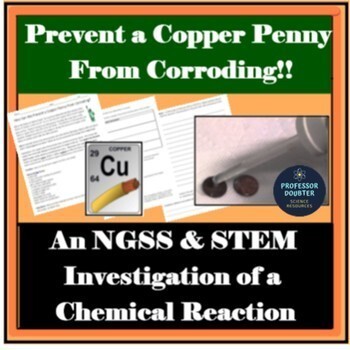Chemical Change STEM Lab NGSS Middle School Experiment MS-PS1-2 MS-ETS1-1
- PDF
What educators are saying
Also included in
- This NGSS Next Generation Science Standards for Middle School Science Mega Bundle has ALL of my NGSS labs, lessons, bulletin boards, posters, activities, assessments, projects, and other resources combined into one product (most of which have been or are being edited for distance learning) ! It offePrice $349.99Original Price $521.25Save $171.26
- This NGSS bundle for Middle School science is a bundle of all of my physical science and chemistry labs, lessons, units, activities, and other resources (several bundles included) combined into one product at a DISCOUNT! All resources are aligned to the new NGSS standards. These activities and lessoPrice $98.00Original Price $130.00Save $32.00
- This NGSS projects and STEM bundle for Middle School science is a bundle of 7 projects/assessments combined into one product at a DISCOUNT! All resources are aligned to the new NGSS standards. These projects are sure to fit perfectly into your units as activities along the way or as assessments! ItPrice $22.05Original Price $31.50Save $9.45
Description
This FUN and ENGAGING NGSS middle school STEM lab investigation challenges students to design their own experiment and gather evidence to prevent pennies from going through a chemical reaction and can be used to meet the Next Generation Science Standards Performance Expectation MS-PS1-2. Analyze and interpret data on the properties of substances before and after the substances interact to determine if a chemical reaction has occurred.
In this 2-3 day inquiry-based and engineering lesson, students design an experiment and test coatings to determine which would prevent the corrosion of shiny, new pennies the best! You can provide more or less scaffolding depending on how well your students can design their own experiment! It should be taught after learning the differences between physical and chemical changes/reactions.
Lesson Overview. Students:
- observe and analyze 3 pennies at various stages of corrosion
- develop a plan to prevent the corrosion of pennies given a limited number of materials (engineering and design)
- design and carry out their experiment
- collect data on their coatings
- determine which worked the best and why
- participate in discussion
- answer conclusion questions and reflect
Materials Per Group:
1 petri dish
1 strip of clay (for holding the pennies)
4 shiny pennies (preferable of the same year)
20 mL white vinegar (acidic environment)
1 bottle clear nail polish
1 container of petroleum jelly
1 bottle of white out
3 cotton swabs
Newspaper for desks
Paper towels for clean up
Sticky notes for penny identification
Ideas for discussion are also provided. In the conclusions, students are asked to reflect on the experiment as to what worked, what didn't, what they would revise, why they used a "control penny" and the costs and benefits to each of their coats to relate it to the real engineering process! My students loved this lab! It's a great introductory lesson on how to write and design an experiment as well!
It aligns with the following NGSS Next Generation Science Standards:
MS-PS1-2. Analyze and interpret data on the properties of substances before and after the substances interact to determine if a chemical reaction has occurred.
MS-ETS1-1. Define the criteria and constraints of a design problem with sufficient precision to ensure a successful solution, taking into account relevant scientific principles and potential impacts on people and the natural environment that may limit possible solutions.
MS-ETS1-4. Develop a model to generate data for iterative testing and modification of a proposed object, tool, or process such that an optimal design can be achieved.
Looking for assessments for MS-PS1 standards?
MS-PS1-1 Atoms & Molecules Assessment Questions
MS-PS1-2 Chemical Reactions Assessment Questions
MS-PS1-3 Synthetic/Natural Resources Assessment Questions
MS-PS1-4 Modeling Adding/Removing Heat Assessment Questions
MS-LS1-5 Conservation of Mass Assessment Questions
If you want ALL of the MS-LS1 Matter and Its Interactions Assessments Questions, click here! MS-PS1 Assessment Questions (Includes ideas for design challenge MS-LS1-6) Check back for more NGSS Assessments for Physical, Life, and Earth Sciences!
Let’s Connect!
Follow my store at this link to stay up-to-date on my latest NGSS resources! Click here!
Are you on Facebook? Be sure to follow me on Facebook for NGSS FREEBIES, updates on what I’m working on, and of course, science memes! Professor Doubter's Facebook Page
Interested in other NGSS aligned physical science products? Check out the links below:
Molecules and Compounds Activities
Modeling Molecules with Fasteners
Synthetic and Natural Resources STEM Project
Magnetic Fields and Eating Nails For Breakfast Lab
Modeling Particle Motion, State, and Temperature Lab
Physical and Chemical Changes Minilabs
Dry Ice Demonstration on Sublimation
Potential and Kinetic Energy Worksheet
Rutherford's Discovery of the Nucleus Lab (FREE)
Modeling Analog and Digital Signals Unit
Introduction to Waves Activity
Modeling Reflection of Light Lab
Electromagnetic Spectrum Activity
NGSS Unit Template for Planning (Example Included)
Looking for other NGSS lessons, units, activities, etc.? Check out my store for more here: Store Link.
Buy the bundle and have access to all NGSS resources!
NGSS Physical Science Bundle: Click Here
NGSS Life Science Bundle: Click Here
NGSS Earth Science Bundle: Click Here
NGSS All Resources Bundle: Click Here
Feel free to share my website with colleagues. Each purchase is a license for ONE person to use in a classroom setting per my Terms of Use. Distribution or sharing of any products are in violation of copyright law.
Rate me to earn TPT credits and be sure to follow me to stay up-to-date on my latest NGSS resources!








